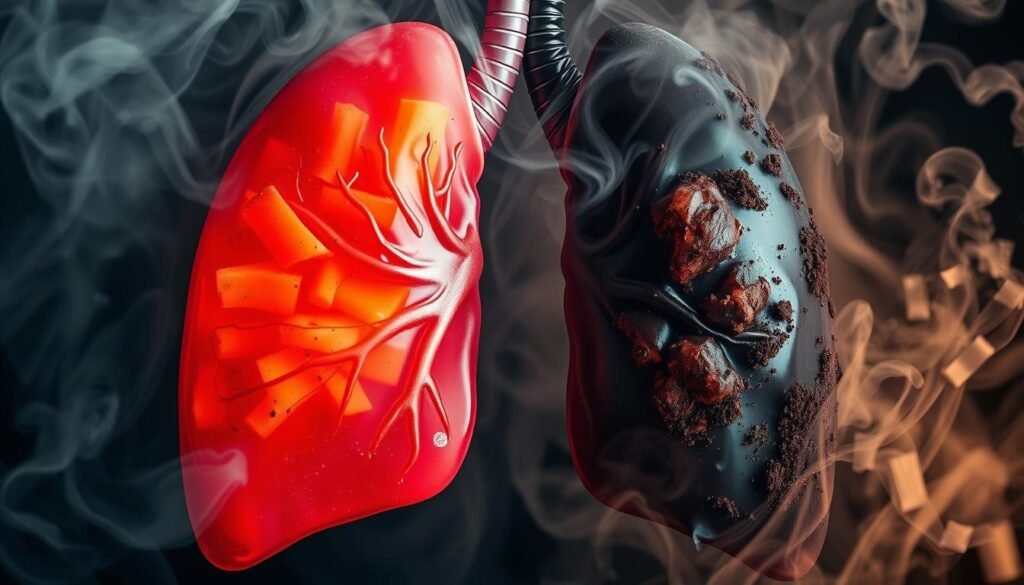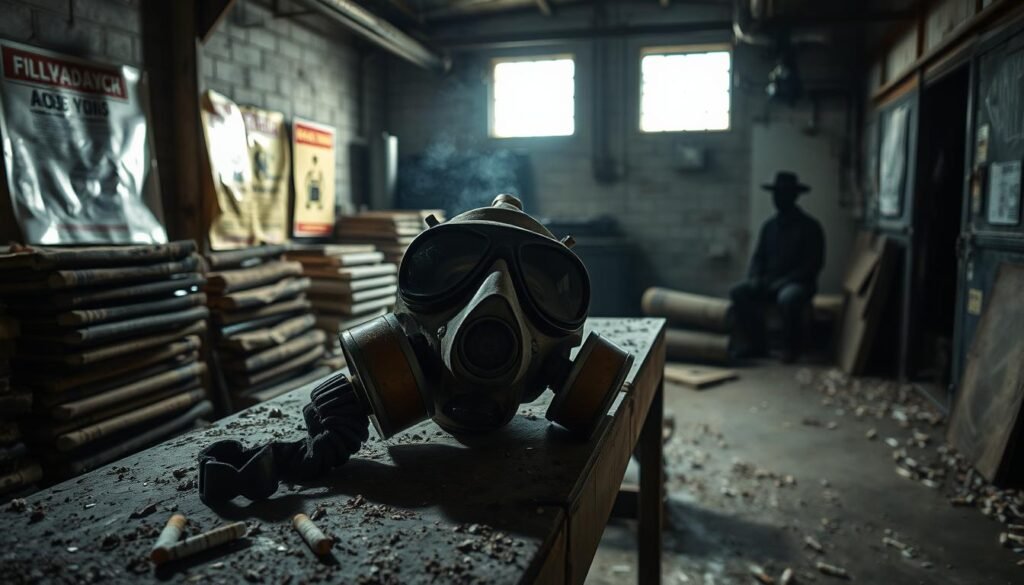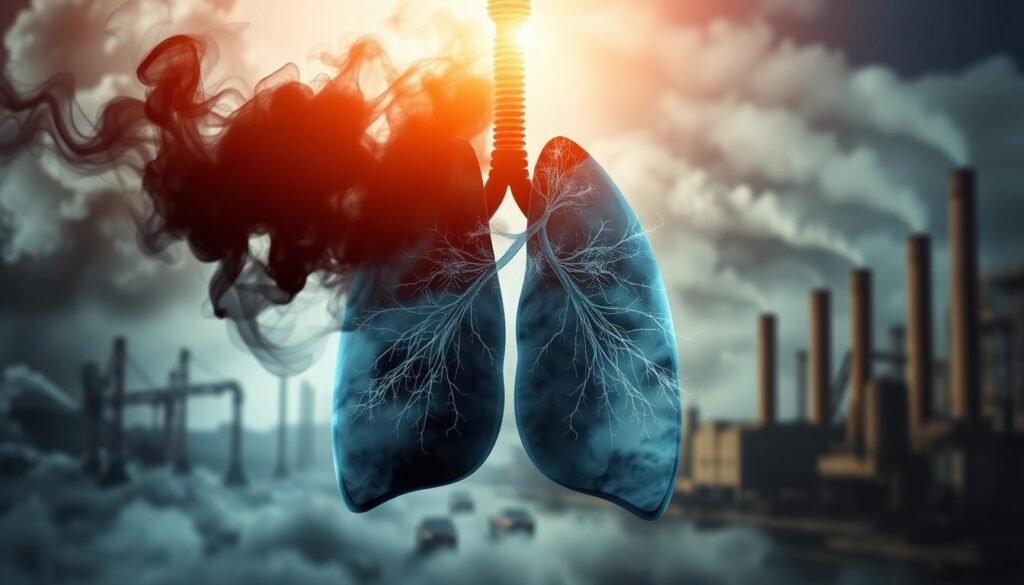In the UK, over 60% of lung cancer cases are caused by tobacco smoke. This includes secondhand smoke too. When you add asbestos to the mix, the danger increases significantly. This “double risk” is worrying for both doctors and everyone else. Studies show smoking and asbestos together make lung cancer more likely than either alone. This raises major health concerns.
It’s important to understand how smoking and asbestos together affect lung cancer risk. It’s not just about the numbers. This complex relationship between the two factors plays a big role in causing lung cancer. We will look into these risks and their effects on lung health in this article.
Key Takeaways
- Over 60% of lung cancers in the UK are linked to smoking.
- The combination of smoking and asbestos exposure significantly raises lung cancer risk.
- Asbestos exposure alone accounts for only 6-8% of lung cancer cases.
- Smokers with asbestos exposure face a 50-fold increase in lung cancer risk.
- Research shows that quitting smoking can substantially lower cancer-related mortality.
Introduction to Smoking and Asbestos
Smoking is the top cause of preventable death in the United States. Asbestos is a major cause of work-related deaths around the world. Many people don’t fully understand the dangers of asbestos. They think it only leads to asbestosis and mesothelioma. But asbestos also plays a big role in other lung diseases, like lung cancer.
Research has long shown that smoking and asbestos are bad for health. Asbestos, a known carcinogen, makes many workplaces dangerous. This is especially true for people working in shipbuilding and construction. They are at a higher risk of lung diseases due to asbestos.
In the U.S., asbestos use dropped from about 803,000 metric tons in 1973 to 360 tons in 2015. But the health risks remain high. People who work with asbestos and smoke face a much greater danger of lung cancer. Smoking is linked to 70% to 90% of lung cancer deaths worldwide.
Even a short time exposed to asbestos can harm your health. The time from exposure to illness appearing can take 10 to 40 years. This delay makes it harder to connect asbestos exposure, smoking, and serious lung diseases.
Understanding Lung Cancer Risk Factors
Lung cancer risk factors affect both smokers and non-smokers. Smoking is the main cause for 80% to 90% of lung cancer cases. This information comes from the Centers for Disease Control and Prevention. Smokers not only raise their own risks but also face greater danger with substances like asbestos. Asbestos exposure notably boosts lung cancer risk.
Jobs with asbestos exposure contribute to about 4% of U.S. lung cancer cases.
Smoking and asbestos have a combined effect, raising lung cancer chances even more. Studies show workers in asbestos-rich environments who smoke are much more likely to get lung cancer. Certain asbestos fibers, like crocidolite and amosite, are especially linked to cancer. Knowing these risks is key.
Who gets lung cancer also varies with demographics. Gender differences in smoking and asbestos jobs lead to different cancer risks. About 12% of those with asbestosis end up with lung cancer. Both smoking and asbestos damage the lungs over years, leading to health problems.
- Smoking as the primary cause of lung cancer.
- Asbestos exposure significantly increases lung cancer risk.
- Demographic variations influence cancer incidence rates.
how does smoking increase the risk of lung cancer in someone exposed to asbestos
When you smoke and are also exposed to asbestos, your lung cancer risk goes up a lot. Knowing how these two harmful substances work together shows the big challenges people face. Smoking alone can make lung cancer more likely. But if you breathe in asbestos too, the risk gets even higher.
Mechanisms of Interaction
Smoking fills your lungs with bad chemicals. These chemicals weaken your immune system. This makes it harder for your body to fix the damage from breathing in asbestos. Being exposed to asbestos causes long-term swelling and cell damage. And smoking makes it worse. This means the harm from both smoking and asbestos adds up, making things really bad for your lungs.
Cumulative Exposure and Lung Damage
Being around both smoke and asbestos really damages your lungs. Research shows that people exposed to both are at a much higher risk of lung cancer. It’s more than if they were exposed to just one. Here’s a table that explains how these risks combine:
| Factor | Increased Risk with Smoking | Increased Risk with Asbestos | Combined Risk |
|---|---|---|---|
| Primary Risk Factor | 80% | Varies (higher with dose) | Exceeds additive model |
| Type of Cancer | Lung Cancer | Mesothelioma and other cancers | Lung Cancer |
| Synergistic Effect | Significant | Significant | Multiplier effect observed |
This table shows that smoking and asbestos together are really bad for your lungs. Smoking raises lung cancer risk and makes asbestos’s effects worse. Together, they form a big hazard to lung health.
The Synergistic Effects of Tobacco Smoke Exposure
Combining tobacco smoke and asbestos exposure increases lung cancer risks. People facing both are at a higher risk. It’s important to understand how these effects add up for public health and prevention.
Impact on Immune Response
Tobacco smoke weakens the immune system. Smokers have a harder time fighting off substances like asbestos. This lowered immunity raises the chances of getting respiratory infections and problems from asbestos inflammation.
The immune system struggles more with both exposures. This can cause more lung damage as the body tries to heal from ongoing inflammation.
Damage to Lung Tissue and Functionality
Being around tobacco and asbestos harms lung tissue. Research shows tobacco smoke makes asbestos damage worse, leading to lung problems. As lungs get worse, breathing becomes harder. People might get chronic lung diseases or cancer.
This damage shows how crucial it is to know about these risks. Those in dangerous jobs need to take steps to stay safe.

| Exposure | Impact on Immune Response | Lung Tissue Damage | Health Risks |
|---|---|---|---|
| Tobacco Smoke | Reduces immune efficiency | None direct, but exacerbates existing damage | Increased risk of infections, lung cancer |
| Asbestos | Causes local inflammation | Leads to lung tissue scarring | Lung cancer, asbestosis |
| Combined Exposure | Severe impairment of immune function | Accelerated damage and dysfunction | Significantly higher lung cancer risk |
We need to know how tobacco smoke and asbestos together affect health. Those at risk should find information and help to protect themselves.
Statistics on Lung Cancer Related to Asbestos and Smoking
Lung cancer is a major health problem worldwide. It is linked to asbestos and smoking. Many people who worked with asbestos also smoked. This has led to many cases of lung cancer.
Comparative Risk Levels
Smoking greatly increases lung cancer risk, especially for those exposed to asbestos. Workers exposed to asbestos who smoke are 28 times more likely to die from lung cancer. Smoking alone raises lung cancer risk by 15 to 30 times.
When combined with asbestos exposure, the risk jumps even higher.
Prevalence Among Asbestos Workers
Many asbestos workers also smoke, ranging from 50% to 80%. This high rate of smoking among asbestos workers raises lung cancer cases. Sadly, those diagnosed have low five-year survival rates.
It’s crucial to reduce smoking and asbestos exposure to lower these risks.
| Statistic | Value |
|---|---|
| New lung cancer cases in 2022 | 236,740 |
| Lung cancer deaths in 2022 | 130,180 |
| Percentage of lung cancer in nonsmokers | 10% to 20% |
| Gender breakdown of new cases | 117,910 men, 118,830 women |
| Average daily deaths of women from lung cancer | 171 |
| Percentage of lung cancer cases diagnosed at early stage | 16% |
| Number of new mesothelioma cases each year | 3,000 |
| Risk increase for asbestos workers who smoke | 28 times higher |
Occupational Hazards in Asbestos Exposure
Asbestos exposure in workplaces is a serious risk. Every year, over 200,000 deaths worldwide are due to it. This accounts for more than 70% of all work-related cancer deaths. Workers in construction, shipyards, and factories face high risks from asbestos. They deal with it often because of the materials they use.
Asbestos was once praised for its insulating and fire-resistant properties. However, it causes severe health issues like lung cancer, asbestosis, and mesothelioma. Workers exposed to asbestos need regular health checks. Symptoms can take years to show up. These checks often include chest x-rays to spot any lung damage.
To lower the risks from asbestos, protective steps are important. Many countries have banned its use. Over 50 WHO member states also have laws to protect workers. Awareness programs help workers understand the dangers of asbestos and the need for safety measures at work.

Table 1 highlights the sources and impact of asbestos exposure across different industrial workplaces:
| Industry | Common Sources of Asbestos Exposure | Health Outcomes |
|---|---|---|
| Construction | Insulation materials, roofing | Asbestosis, lung cancer |
| Shipbuilding | Asbestos lagging, pipe insulation | Pleural plaques, lung cancer |
| Manufacturing | Asbestos products (e.g., tiles, textiles) | Mesothelioma, lung cancer |
| Repair & Renovation | Older building materials containing asbestos | Chronic respiratory diseases |
Handling asbestos dangers requires careful management and ongoing education about asbestos exposure risks. Industrial workplaces must follow detailed safety protocols to keep all workers safe.
Preventive Measures Against Lung Cancer
To lower the risk of lung cancer, taking preventive steps is key. Quitting smoking, and becoming aware of asbestos risks are essential. Together, they protect your health.
Quitting Smoking Strategies
For those trying to quit smoking, there are many helpful strategies. These methods offer support throughout the quitting process. They include:
- Support Groups: Sharing goals with others can motivate you.
- Cessation Programs: Programs offer counseling and workshops. Medication is also available.
- Behavioral Therapy: This finds what triggers you and helps you cope.
- Nicotine Replacement Therapy: Products like patches help ease withdrawal symptoms.
Quitting smoking greatly improves your health, data shows. It’s most effective in the first few years of quitting. Over time, it’s possible to reduce your risk to that of a non-smoker.
Awareness of Asbestos Risks
Becoming aware of asbestos risks is critical, especially in certain jobs. Information campaigns teach about asbestos’s dangers. This is crucial in industries like construction or shipbuilding.
- Workplace Training: Workers learn how to safely handle asbestos.
- Regular Inspections: Workplaces are checked for asbestos to keep everyone safe.
- Health Monitoring: Regular health checks for those exposed to asbestos.
Knowing about asbestos can prevent lung cancer. When people are informed, they help make environments safer and healthier.
| Strategy | Effectiveness | Timeframe for Benefits |
|---|---|---|
| Support Groups | High | Immediate |
| Cessation Programs | Very High | 6 Months |
| Behavioral Therapy | Moderate | 3-12 Months |
| Nicotine Replacement Therapy | High | Immediate to 3 Months |
| Asbestos Awareness Training | High | Immediate |
The Role of Asbestosis in Lung Cancer Development
Asbestosis is a serious lung disease caused by breathing in asbestos fibers for a long time. It greatly increases the chance of getting lung cancer. People with asbestosis have inflamed lungs and scarring. This makes it easier for cancer to start. Symptoms often don’t show up until 10 to 40 years after being exposed, which makes it hard to catch early.
For those who smoke and have asbestosis, the risk is even higher. Smoking makes it harder for your lungs to get rid of asbestos fibers, causing more damage. Thus, smokers with asbestosis have a bigger risk of developing lung cancer because of the damage from both conditions.
Jobs like construction and auto repair exposed many workers to asbestos, increasing their risk of asbestosis and lung cancer. Safety rules now help protect people in these jobs. But people living with workers may also be exposed at home. This makes preventing health problems from asbestos even more complicated.

Studies are helping us understand how asbestosis leads to lung cancer. The risk is affected by how much and how long you’re exposed to asbestos. It also depends on your overall health and if you have other lung problems. Stopping the use of asbestos and awareness are key to prevent more cases of asbestosis and lung cancer.
Research Findings on Smoking and Asbestos Interaction
The link between smoking and asbestos has been studied for years. Findings show a strong link to lung cancer risk. The risk of lung cancer rises a lot when someone smokes and is exposed to asbestos, more than with either alone. People knew about the dangers of asbestos and lung cancer since the 1930s.
Case Studies and Epidemiological Data
About 12% of those with asbestosis may get lung cancer. If you’re around asbestos for 20 years or more, your lung cancer risk is ten times higher than usual. Studies found 13.2% of asbestosis patients got lung cancer. In comparison, only 1.3% of those with silicosis did. Different types of asbestos fibers, like crocidolite and amosite, affect lung cancer risk in their own ways.
Smoking and asbestos together almost certainly increase cancer risk. A 2013 study showed a 28-fold increase in lung cancer deaths among insulation workers exposed to both. This underlines how bad smoking and asbestos are together. For more details, see this in-depth study.
Future Research Directions
Future studies need to tackle a few key issues. We need to understand exactly how smoking and asbestos together increase cancer risk. Knowing how different asbestos fibers affect risk can help create better safety guidelines. Better data on how these factors lead to lung cancer is also crucial.
Conclusion
It’s crucial to understand how smoking and asbestos together increase lung cancer risks. This article shows the high risk of lung cancer, the top cancer killer in the U.S. Only 17 out of 100 people survive beyond five years after their diagnosis. This shows how vital it is to raise awareness about lung cancer.
People need to know about the dangers of asbestos, especially those who work with it. Diseases from asbestos can show up 15 years after first being exposed. When you also use tobacco, the risk rises. This calls for a push towards healthier living and preventive actions to lower lung cancer rates.
We need to keep educating people about lung cancer due to smoking and asbestos. To get more info on lung cancer and its risks, check this link. Health education is a powerful tool in fighting the impact of lung cancer.